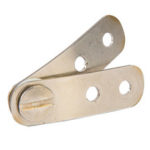
Third graders in Birmingham, Alabama play an impromptu game of kickball on their last day of school. (Photo by ES Delzell.)
Game sends 10,000 kids a year to ED
By Emily Delzell
Kickball, a traditional and ubiquitous schoolyard game children often begin playing as early as preschool, has higher rates of injury than martial arts and tennis, according to an epidemiological review from the University of Pennsylvania that calls for heightened awareness of the risks and modifi- cations to the way the game is played.
Despite kickball’s popularity in the US, this is believed to be the first study of the national health burden of injuries sustained during the game, according to lead author Kevin Pirruccio, a rising third-year medical student at the University of Pennsylvania’s Perelman School of Medicine in Philadelphia.
Pirruccio, who plans to pursue a residency in orthopedic surgery, and his coauthors from the Division of Orthopaedics at Children’s Hospital of Philadelphia, noted in their study that while pediatric injury risks from playing baseball, dodgeball, and handball have all been “well characterized and determined to be substantial,” kickball blends elements of all these games without getting similar scrutiny.
“We chose to investigate kickball injuries because the game is similarly popular, but frequently overlooked as a sport since it is often played recreationally and with children in younger age groups,” he said. “In addition, we had recently noticed that several of our patients who had presented with severe fractures requiring surgery had sustained the injuries while playing kickball, thus garnering our attention. Even so, what ended up surprising us most was the sheer volume of injuries—over ten thousand per year—presenting to US emergency departments associated with such a common childhood game otherwise bereft of the tackles, takedowns, and high-velocity impacts that often characterize sports with high injury burdens.”
The study retrospectively analyzed 18 years of data (2000-2017) from the National Electronic Injury Surveillance System (NEISS) to identify annual cases of kickball-related injuries that sent youths aged 18 years and younger to US emergency departments for care. Pirruccio and his colleagues found that, on average, 10,644 kids with kickball-associated injuries presented to US emergency departments each year. Kickball injury rates held steady during the period the study looked at, with no significant change in the number of injuries between 2000 and 2017.
The severity of injuries reported in the study reflected what Pirruccio and colleagues were seeing among patients in their clinic. More than half the injuries were classified as moderate to severe; 34.4% were sprains, strains, or muscle tears, while another 24.8% were fractures. Contusions or abrasions were also common (18.3%), and the most frequently injured sites were the ankles (13.7%) and fingers (17.1%).
The investigators also looked at patient demographics to identify the groups at highest risk for injury. Boys sustained 60.7% of the injuries, and children aged 10 to 12 years had the greatest proportion of injuries (44.4%), though they were followed closely by those aged 7 to 9 years (23.5%).
The sheer volume of kickball-related injuries per year is most striking when compared with the incidence of injuries reported with other activities, said Pirruccio. Other studies have found that martial arts send about 9000 children per year to the emergency department—10% less than kickball—while tennis, which involves rapid changes in direction that can lead to ankle injuries, has an even lower annual injury rate (6500 emergency department admissions per year in the US).
The current study also found that more than half (54%) of kickball-related trauma happened in school settings and that injury rates rose during the mildest seasons of the year.
“The fact that injury rates were highest in the fall and spring may reflect physical education teachers more frequently electing to have their classes play kickball outside when the weather is more temperate,” he said. “Overall, this health burden is especially troubling because kickball-related injuries occur in spite of adult supervision and at institutions intended to minimize risks to students.”
Awareness is a crucial first step in injury prevention, said Pirruccio, who stressed that the study’s findings should not be taken as evidence that gym teachers must avoid kickball as an option for a class activity.
“Instead, we suggest that gym teachers individually consider the outdoor and indoor environments at their respective schools, the quality and condition of the balls they use for kickball, and whether students wholly understand and will implement rules ensuring their safety,” he said. “As an example, this may motivate some teachers to use any combination of indoor play, replacing rubber balls with foam balls, or reviewing rules about diving catches in order to improve safety. Similarly, clinicians may benefit from a greater suspicion for both finger and ankle sprains if a pediatric patient presents with an injury sustained while playing kickball.”
Sources:
Pirruccio K, Weltsch D, Baldwin KD. Kickball and its underappreciated pediatric injury burden: An 18-year retrospective epidemiological study. Orthop J Sports Med. 2019 Apr 2;7(4):2325967119835894.
Gaw CE, Chounthirath T, Smith GA. Tennis-related injuries treated in United States emergency departments, 1990 to 2011. Clin J Sport Med. 2014;24(3): 226-232.
Yard EE, Knox CL, Smith GA, Comstock RD. Pediatric martial arts injuries presenting to emergency departments, United States 1990-2003. J Sci Med Sport. 2007;10(4):219-226.





